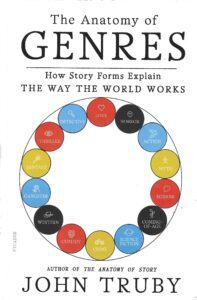Truby Outlines Genres

John Truby. 2022. The Anatomy of Genres: How Story Forms Explain the Way the World Works. New York: Picador.
Review by Stephen W. Hiemstra
The logic and beats that structure genres in literature and screenplays are often mysterious. Sure, some authors make their careers writing in a particular genre, but the usual advice offered when questions come up is to figure the category out by reading five to ten books that typify it. Closer to the truth is the observation that genres often seem defined by wish-fulfillment as they scratch a particular itch, like characters who are especially clever, powerful, or attractive.
IntroductionIn his book, The Anatomy of Genres, John Truby writes: “Genres are types of stories: Detective, Love, Action, Fantasy, or Science Fiction.” (3) He then goes on to state:
“Story is a philosophy of life expressed through characters, plot, and emotion. It shows life as art. That’s why stories are the universal building blocks of religion and always have been. Story transcends specific religions, each of which is a collection of stories about how to live an ethical life.” (6)
The bold claims don’t stop here. He writes: “If human life is poetics, the knowledge we get from story is the greatest knowledge of all.” (7) Truby purpose in writing is: “to reveal to the world the deep structures of story and genre.” (8) He claims that the fourteen genres outlined in his book account for ninety-nine percent of the stories today. Those genres are: horror, action, myth, memoir, coming-of-age, science fiction, crime, comedy, western, gangster, fantasy, thriller, detective, and love (10).
Background and OrganizationJohn Trudy studied film studies and screenwriting at University of Southern California. He is an author with several books, including The Anatomy of Story: 22 Steps to Becoming a Master Storyteller.
Truby writes in fourteen chapters;
The world as storyHorror ReligionAction: SuccessMyth: The life processMemoir and coming-of-age story: Creating the self through fiction and nonfictionScience fiction: Science, society, and cultureCrime: Mortality and justiceComedy: Manners and moralsWestern: The rise and fall of civilizationGangster: The corruption of business and politicsFantasy: The art of livingDetective story and thriller: The mind and the truthLove story: The art of happinessThe future of storytelling (vii)These chapters are followed by an appendix and acknowledgments.
The World as StoryTruby sees a dialectical relationship between art and life. If art provides a lens with which to interpret life, it also shapes the life we live (20). This dialectical relationship arises because Truby sees story as instrumental in the articulation of religion (22). Truby cites three rules for storytelling:
The storytelling business is all about buying and selling genres (8).Popular stories today combine 3-4 genres (11).To rise above the crowd, the writer must transcend the primary genre (14).Truby divides cinematic history into two parts: Before and after Star Wars (13). Star Wars combined fantasy with space, science fiction, romance, coming-of-age, and cowboys in space genres. Before Star Wars, movies concentrated on a single genre, like Jaws (1975) was primarily a horror film (11).
This dichotomous view of cinematic history is interesting because life itself is seldom an articulation of any particular genre. Describing a film as multi-genre comes closer to our actual experience of life. This description also parallels the modern period’s focus on the existence of one, objective truth and postmodern period’s acceptance of truth as having multiple dimensions, depending on perception, experience, and preferences. My truth may differ from your truth, much like authors may write from different points of view (POV).
Western and Anti-WesternTruby’s comments about the western are particularly interesting. He sees the western as the American creation myth that is based on the “belief that we can reinvent ourselves at any time, over and over again.” (402) This is myth of progress. “The classic Western shows us history as linear progress, literally moving from east to west and conceptually tracking the rise of civilization from corruption towards perfection.” (407)
The cowboy tames the wilderness, making room for farmers, small towns, and civilization, then retreats to the wilderness to start the process over and over. A classic western film is Shane (1953). The anti-western arises once the frontier is finally tamed, leaving no further room for the cowboy who inevitably dies (407). The classic anti-western film is Butch Cassidy and the Sundance Kid (1969).
Star Trek (1966) and Star Wars (1977) became cultural classics because they elevated the cowboy to space: The final frontier. It seems ironic that Star Wars went on to motivate the last president to tap into the cowboy motif, Ronald Regan, to adopt a Star Wars 1983 initiative (The Strategic Defense Initiative) only a few years later. Some will recall that Reagan, during his acting career, hosted a popular television series (1964-66) called Death Valley Days that featured weekly western dramas.
One of the most successful political ads ever, It’s Morning In American (1984), by Ronald Reagan focuses on this myth of progress. The theme harkens back to the American frontier and the optimism of eternal progress. Several presidents after Reagan have returned to this theme only to disappoint their followers because the frontier is no longer. Life in the anti-western means that optimism must be based on something other than the frontier.
AssessmentJohn Truby’s book, The Anatomy of Genres: How Story Forms Explain the Way the World Works, is a highly readable and encyclopedic work that explains the structure and logit of fourteen genre’s in literature and film. Anyone interested in understanding and writing fiction should find this lengthy work (710 pages) worth reading and studying.
Footnoteshttps://en.wikipedia.org/wiki/John_Truby. https://truby.com. http://johntrubysscreenwriting.blogspot.com.
Truby Outlines GenresAlso see:Savage: Listening & Caring Skills: Sacks: Why Stories Sell, Part 1Books, Films, and MinistryOther ways to engage online:Author site: http://www.StephenWHiemstra.netPublisher site: http://www.T2Pneuma.com Newsletter at: https://bit.ly/Janu_25, Signup
The post Truby Outlines Genres appeared first on T2Pneuma.net.



